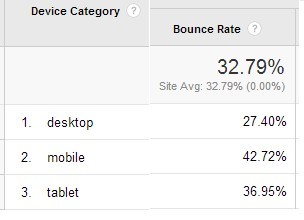
I think that bounce rates get a bad rap. I do always prefer a low bounce rate to a high one, but sometimes a high bounce rate isn’t such a bad thing. Let’s dig in to what a bounce rate is a bit.
A bounce rate is the percentage of sessions (visits) that leave after visiting a single page and doing nothing else. This leaves a fairly large range of potential types of bounces. You could have a low quality bounce where a visitor leaves immediately or a high quality bounce where people only visit one page but stay for a while.
So already by looking into this bounce rate definition more carefully we can see that a bounce rate is not a simple “bad” percentage. In fact, you could imagine a situation where a high performing page has a high bounce rate because it’s giving people info that they want. Of course, there may be better ways to set up your tracking so those don’t show up as pure bounces, but that’s a topic for another time (think event tracking and virtual page views).
Another important component to consider when looking at bounce rates is the device type. Mobile bounce rates tend to be higher than non-mobile by about 10 to 20 percent. Tablets, on the other hand, are a little less predictable but tend to be somewhere between desktop and mobile:

Finally, different industries have dramatically different bounce rates. People looking up events are going to bounce away more because they just want the date and time, as opposed to people seeking out highly specific content.
One great suggestion I’ve heard many times from many places is to set small goals for yourself regarding improving specific elements of your site. One great little trick you can use to help you identify weak portions of your site is the content drilldown section within the behavior tab of Google Analytics.

Note that in this image we see various sub sections of the given site. Each sub directory is listed, so if we have /upcoming-shows/opera and /upcoming-shows/hip-hop they would both be within the same section. When using this trick be sure to consider carefully the types of pages you’re looking at. For instance, this picture shows the /upcoming-shows/ section with a significantly higher bounce rate than the average, but if we consider the content in there this makes sense, and thus isn’t necessarily a good candidate for us to focus our efforts on.
In summary, bounce rates aren’t always something to cry over, but when you’re using it as an internal comparison among different sections of your site it can be a powerful metric to help you most efficiently improve your site.
